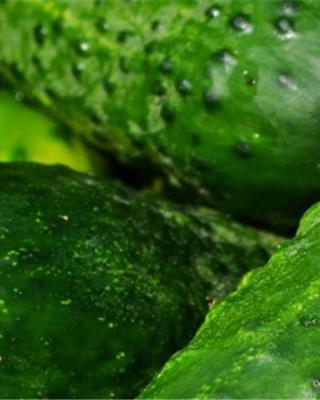
Planting cucumbers on the balcony tips and tricks
- Discover
- Gardening inspiration
- magazine
- Planting cucumbers on the balcony tips and tricks
Fancy a fresh snack? No problem. Just plant a couple of cucumbers on the balcony in the spring and enjoy them in the summer.
It doesn't get much fresher than that.
Cucumbers are one Europe's most favourite vegetables and are found in many countries. They also thrive on the balcony. However, there are some rules for successful cultivation outside the garden. Starting with the right container.
In nature, the roots have plenty of room to spread out. They need this even on the balcony. This rules out the usual flower boxes. Tubs or pots with a volume of at least ten litres are better. They should also be higher than they are wide and have a drain for water. Cucumbers do not tolerate water logging. Cucumbers also like plenty of room. This means the distance between individual plants should be no less than 20 cm.
And as they are originally from India, they prefer a sunny spot, sheltered from the wind. The south side of the balcony is a good choice.
Suitable varieties are the blue cucumber tree, cucumbers for salad, snake cucumbers and gherkins.
The prerequisite for a splendid harvest is the soil. This should be rich in humus, loose and air-permeable. For the cucumbers to thrive, use an organic fertiliser every week containing potassium, phosphorus and magnesium, but no nitrogen. Prepare the mixture as follows – fill a watering can with nettles and discarded cucumber shoots and fill up to the top with water. Leave this brew to stand and ferment for two weeks.
Then, it's ready for use. If you want to spare yourself the effort, add long-term fertiliser to the soil at the beginning.
Growing in substrate is best done inside the house from March onwards. Place the container with the soil on a bright windowsill. Cucumbers do not like cold temperatures, so it should be at least 15°C. Now you can start sowing.
Press the seeds about 1 cm into the soil and cover them with soil to the depth of a finger. Water regularly to keep them constantly moist. This is important because cucumbers on the balcony need a lot of water. It takes about a week until the seedlings sprout.

Once the young plants have reached a height of approximately 25 cm, they are ready to be transplanted to their final location on the balcony. Encourage further growth by standing a trellis in the soil of the tub or pot. Alternatively you can place the cucumbers directly in front of a balcony railing and let them climb it. These climbing frames prevent the plants from drooping, which they can do once they start bearing fruit.
The cucumbers start to ripen three weeks after the start of flowering – i.e. between July and October. When you harvest them depends on what you want to do with them. If you want to pickle them for cornichons, they should be between 4 and 6 cm long. Gherkins can be up to approximately 12 cm, and cucumbers between 20 and 30 cm.
They are not just harvested once, but every two to three weeks. The ideal time can be determined by the colour and also the length. Ripe cucumbers have a uniform green colour. The exception is peeling cucumbers. These are ready to pick when they turn yellow. Take care when picking – the sensitive vines tear easily. It's best to use a knife to remove the stems of the fruit. They are best harvested in the morning or early afternoon because that's when the cucumbers contain the most nutrients. Trim new flowers towards the end of September. This ripens the new cucumbers.
A rich cucumber harvest is sometimes thwarted by pests and diseases. Act quickly at the first signs of these. The most common threats include:
An unfavourable location and incorrect care encourage diseases and pests. Therefore, you should observe the following points. Maintain the minimum distance of 20 cm, because the closer together the cucumbers, the greater the likelihood of them becoming infected. This also causes water logging. However thirsty the plants, you should not overdo the watering. The location must be protected from drafts and the floor kept free of germs. If the substrate is contaminated, you need to discard and replace it along with the infected plants.
The emergence of pests such as aphids, thrips, white fly and spider mites is alarming. Take action at the first signs of infection with commercial pesticides, if necessary.
